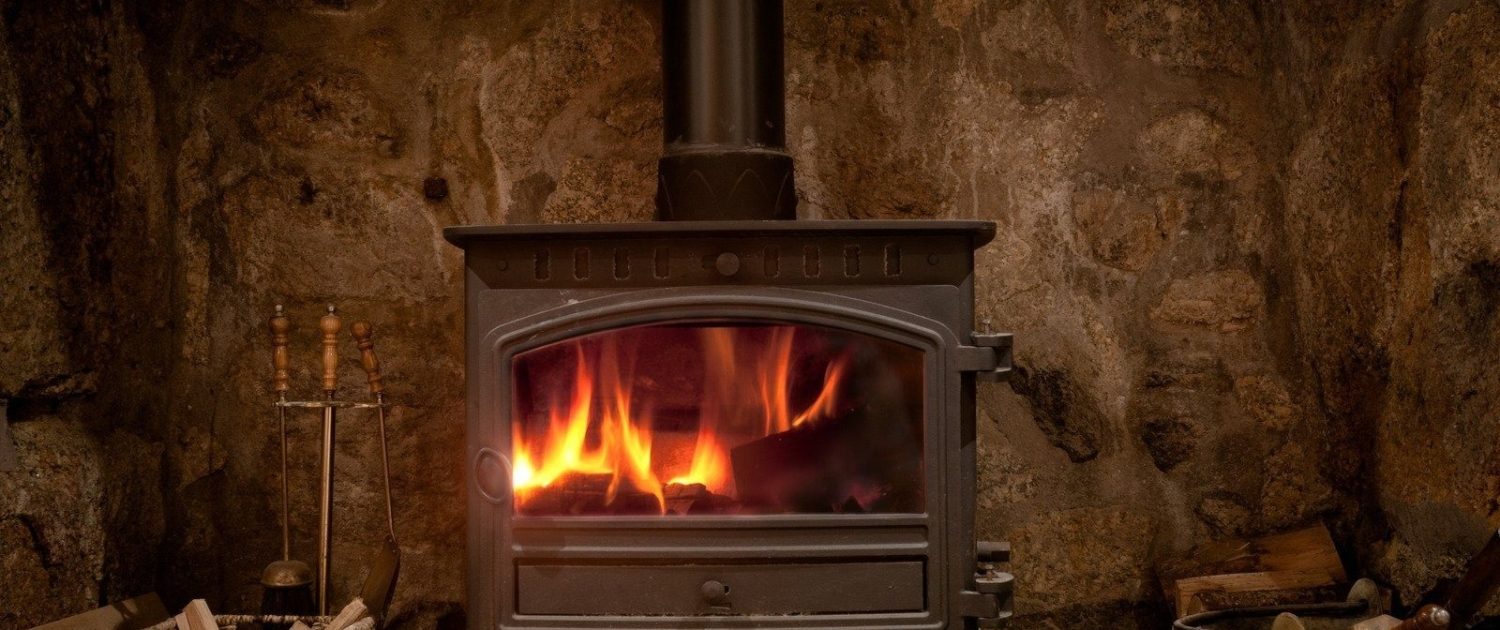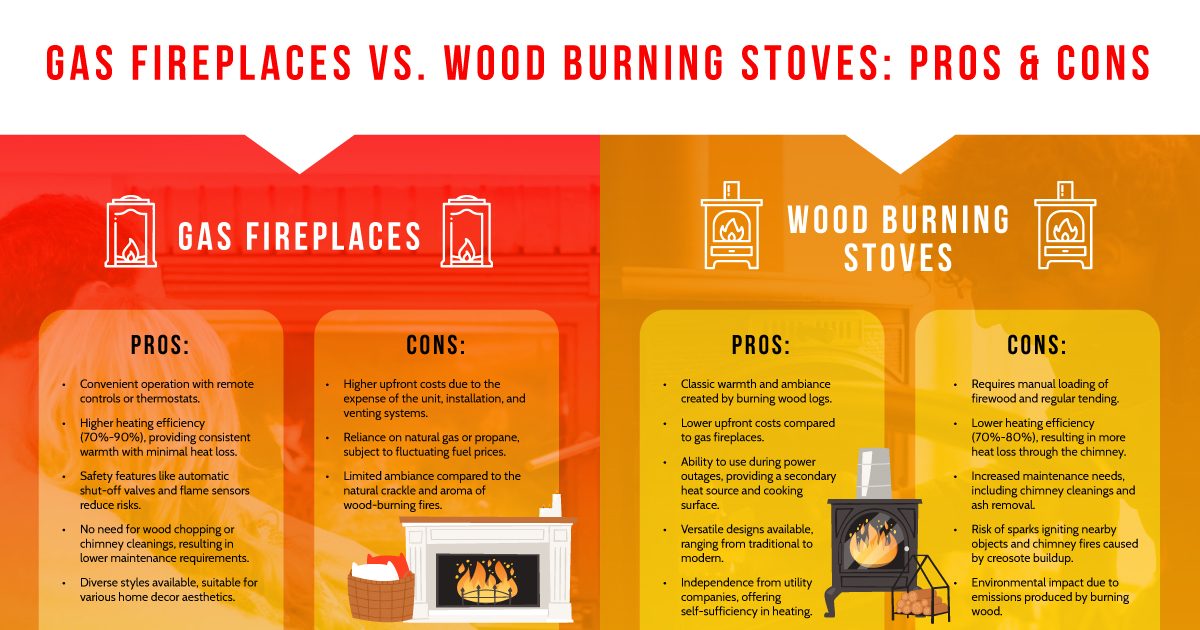Gas Fireplaces vs. Wood Burning Stoves: A Comprehensive Guide
When it comes to adding warmth and ambiance to your home, few things beat the crackling glow of a fireplace. However, with so many options available, choosing gas fireplaces vs. wood burning stoves can be a daunting task. Each has its own set of advantages and drawbacks, making the decision a matter of personal preference and practical considerations. In this article, we discuss the primary considerations such as heating efficiency, safety, maintenance, and cost, to help you make an informed choice.
Gas Fireplaces
A gas fireplace is a modern heating appliance that simulates the look and feel of a traditional wood-burning fire using natural gas or propane as fuel. These fireplaces typically feature realistic ceramic logs or glass crystals that are illuminated by a gas burner. Gas fireplaces come in a variety of styles, including traditional, contemporary, and linear designs, making them suitable for any home decor aesthetic. Unlike wood burning stoves, gas fireplaces require no hauling or storing of firewood. They can be easily controlled with a remote, wall switch, or thermostat. Additionally, gas fireplaces are vented through an existing chimney or installed as vent-free units, providing flexibility in placement and installation options. Overall, gas fireplaces offer convenience, efficiency, and safety, making them a popular choice for modern homeowners.
Wood Burning Stoves
A wood burning stove is a classic heating appliance that burns wood logs to produce warmth and ambiance. These stoves typically feature a firebox enclosed in a steel or iron body that vent smoke outside with a chimney. Wood burning stoves come in a variety of styles, ranging from traditional cast iron designs to sleek modern models. Wood burning stoves are a versatile option for rustic cabins contemporary homes alike. Unlike gas fireplaces, wood burning stoves require manual loading of firewood and regular tending to maintain a steady flame and temperature. However, the natural crackle and aroma of burning wood create a cozy atmosphere that many homeowners find irresistible. Overall, wood burning stoves combine timeless charm with practical functionality. They offer a reliable and efficient way to heat your home while enjoying the timeless appeal of a real wood fire.
Heating Efficiency Comparison
One of the key factors to consider when selecting gas fireplaces vs. wood burning stoves is the difference in heating efficiency. On average, wood burning stoves achieve heating efficiencies of 70%-80% where gas fireplaces typically operate around 70%-90%. Gas fireplaces are generally more efficient than their wood burning counterparts. Gas fires can produce a consistent heat output with the flick of a switch, providing instant warmth to your space. Since the flames are contained within a sealed unit, they tend to lose less heat through the chimney. On the other hand, wood burning fires require more effort to maintain a steady temperature and can lose a significant amount of heat through the chimney. In order to ensure proper efficiency, make sure to keep up with routine maintenance and inspections. Learn more about heating efficiency and cost here.
Does Gas or Wood Give Off More Heat?
Generally, wood burning stoves tend to emit more heat than gas fireplaces. Wood burning stoves produce heat through the combustion of solid wood fuel, which can generate intense warmth. The combustion process releases a significant amount of heat energy, which warms the stove’s metal body. This heat is then radiated outward into the room, providing cozy warmth. Additionally, some wood stoves feature blowers or fans that help distribute heat more evenly throughout the space, further enhancing their heating capabilities. Gas fireplaces, on the other hand, typically provide consistent heat output and can be controlled easily with a thermostat or remote control. While they can still produce ample heat, their heat output might be lower compared to wood-burning stoves, especially in terms of radiant heat. However, gas fireplaces often have higher efficiency ratings, meaning more of the heat generated stays within the home rather than being lost through the chimney.
Which Option is the Safest?
Safety is paramount when it comes to installing and using a fireplace. Gas fireplaces are often considered safer than wood burning ones due to their controlled flames and lack of flying embers. With gas fires, there’s no need to worry about sparks igniting nearby objects or chimney fires caused by creosote buildup. Although with proper chimney maintenance and inspection the risk of owning a wood burning stove is minimal. Learn more about proper chimney maintenance and ventilation here. Lastly, gas fireplaces typically come equipped with safety features such as automatic shut-off valves and flame sensors to prevent accidents. However, it’s essential to have any gas appliance professionally installed and inspected regularly to ensure proper ventilation and functioning.
Maintenance Comparison
Understanding the maintenance required for your fireplace is essential before deciding between gas fireplaces vs. wood burning stoves. Gas fireplaces generally require less maintenance than wood-burning ones. With gas fires, there’s no need to chop or store wood, clean out ash, or schedule regular chimney cleanings. However, gas fireplaces do require annual inspections by a qualified technician to check for leaks, ensure proper venting, and clean the burner and logs. Wood burning fireplaces, on the other hand, require more frequent maintenance, including chimney cleanings to remove creosote buildup, ash removal, and occasional repairs to the firebox or chimney liner.
Cost Considerations
Cost is often a significant factor in the decision-making process when it comes to home improvements. Gas fireplaces tend to have a higher upfront cost than wood-burning ones, due to the cost of the unit itself, installation, and any necessary gas lines or venting systems. However, to the more cost effective solution is often the gas fireplace. They require less maintenance and fuel compared wood burning fires. Wood burning fireplaces may have a lower initial cost, but the ongoing expenses of firewood and the labor involved in maintaining and cleaning the fireplace can add up over time. Assuming moderate usage, the annual cost of fuel for a gas fireplace ranges from $200-$500 compared to $450-$1500 for a wood burning stove.
WNC Chimney is Here to Help!
Choosing between a gas vs. wood-burning fireplace ultimately comes down to personal preference and practical considerations. Here at WNC Chimney, our priority is finding the proper solution that best fits your needs. Interested in learning more about the cost of your fireplace project or scheduling a free consultation?









